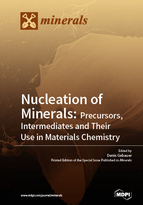Nucleation of Minerals: Precursors, Intermediates and Their Use in Materials Chemistry
A special issue of Minerals (ISSN 2075-163X).
Deadline for manuscript submissions: closed (31 May 2017) | Viewed by 109062
Special Issue Editor
Interests: physical chemistry; materials chemistry; crystallization; nucleation; non-classical crystallization; polyamorphism; pre-nucleation clusters; biomineralization; additive-controlled crystallization; bio-inspired materials
Special Issue Information
Dear Colleagues,
Nucleation is the key event in mineralization, but a general molecular understanding of phase separation mechanisms is still missing, despite more than 100 years of research in this field. In the recent years, many studies have highlighted the occurrence of precursors and intermediates, which seem to challenge the assumptions underlying classical theories of nucleation and growth. This is especially true for the field of biomineralization, where bio-inspired strategies take advantage of the precursors' and intermediates' special properties for the generation of advanced materials. All of this has led to the development of "non-classical" frameworks, which, however, often lack quantitative expressions for the evaluation and prediction of phase separation, growth and ripening processes, and are under considerable debate. It is, thus, evident that there is a crucial need for research into the early stages of mineral nucleation and growth, designed for the testing, refinement, and expansion of the different existing notions. This Special Issue aims to bring together corresponding studies from all these areas, dealing with precursors and intermediates in mineralization processes. We welcome fundamental physical chemical studies, experimental, as well as theoretical, but also detailed analyses and characterizations of the formation mechanisms of both biogenic and bio-inspired, mineral-based (hybrid) materials. We also solicit methodological studies employing cutting-edge in situ analytics. The hope is that this Special Issue will contribute to the achievement of a better understanding of nucleation precursors and intermediates, and their target-oriented use in materials chemistry.
Dr. Denis Gebauer
Guest Editor
Manuscript Submission Information
Manuscripts should be submitted online at www.mdpi.com by registering and logging in to this website. Once you are registered, click here to go to the submission form. Manuscripts can be submitted until the deadline. All submissions that pass pre-check are peer-reviewed. Accepted papers will be published continuously in the journal (as soon as accepted) and will be listed together on the special issue website. Research articles, review articles as well as short communications are invited. For planned papers, a title and short abstract (about 100 words) can be sent to the Editorial Office for announcement on this website.
Submitted manuscripts should not have been published previously, nor be under consideration for publication elsewhere (except conference proceedings papers). All manuscripts are thoroughly refereed through a single-blind peer-review process. A guide for authors and other relevant information for submission of manuscripts is available on the Instructions for Authors page. Minerals is an international peer-reviewed open access monthly journal published by MDPI.
Please visit the Instructions for Authors page before submitting a manuscript. The Article Processing Charge (APC) for publication in this open access journal is 2400 CHF (Swiss Francs). Submitted papers should be well formatted and use good English. Authors may use MDPI's English editing service prior to publication or during author revisions.
Keywords
- mineral nucleation and growth
- non-classical crystallization
- pre-nucleation clusters
- amorphous intermediates
- mineral poly(a)morphism
- formation mechanisms of biominerals
- additive-controlled mineralization
- mechanims of bio-inspired mineralization
- in situ analyses of the early stages of mineralization






